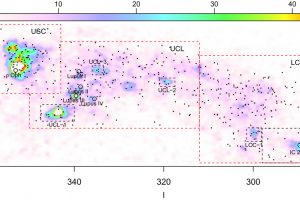Formation and evolution of the Sco OB2 association. The study: “Stellar population of Sco OB2 revealed by Gaia DR2 data” of F. Damiani (INAF-OAPA) recently appeared on A&A

OB associations have a rich population of massive stars (O and B stars), which are young and typically dispersed over large regions of the sky. While these massive stars can be easily recognized thanks to their intense luminosity, it is very hard to select the low mass stars belonging to OB associations. This because without evident stellar concentrations, these stars can be easily confused with the field stars, nearby in our sky but distant in space. A precious instrument to select stars belonging to stellar clusters and associations is the ESA satellite Gaia, which provides very precise measurements of stellar distances and motion. This help discriminating the stars association with clusters and OB associations from contaminating field stars.
Scorpius OB2 (Sco OB2) is the closest OB association to the Sun, with an estimated distance between 400 and 530 light years. Sco OB2 covers a huge area in the sky: about 2000 square degrees. This is a very complex association, where the star formation process started more than 20 million years ago and it is still ongoing in some regions. Despite the large number of published studies on Sco OB2, because of its extent in our sky, it has never been possible to obtain a complete and homogeneous census of its stellar population that would allow to acquire a deep knowledge on its formation and evolution.
This has changed with Gaia and its Second Data Release, which contains precious information on the distance and motion of the stars falling in this region of the sky of Sco OB2. In the study: “Stellar population of Sco OB2 revealed by Gaia DR2 data” of F. Damiani (INAF – Astronomical Observatory of Palermo), data obtained with Gaia are analyzed in order to identify the stellar population of Sco OB2. The authors have selected more than 11000 low mass pre-main sequence stars and more than 3600 main sequence stars member of Sco OB2. From the age of these stars, it has been possible to confirm the star formation chronology of this region found by other authors and to obtain a detailed map of the complex structure of Sco OB2. One of the most important result is the evidence of a rich uncorrelated field stellar population lying approximately ot the same distance of Sco OB2, counting several thousands stars. This general result indicates that the dynamical evolution of an OB association is more dictated by the Galactic gravitational potential rather than the gravity of its own members. The astronomers Loredana Prisinzano, Ignazio Pillitteri, Giuseppina Micela, and Salvatore Sciortino of INAF – Astronomical Observatory of Palermo are co-authors of this study.
The figure (link) shows a stellar density map of Sco OB2 with marked known rich sub-groups and clusters of this region.
by Mario Giuseppe Guarcello ( follow mguarce)
